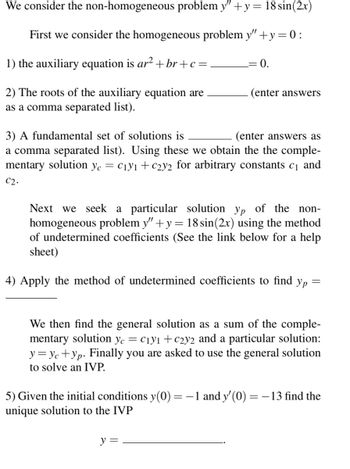
Advanced Engineering Mathematics
10th Edition
ISBN: 9780470458365
Author: Erwin Kreyszig
Publisher: Wiley, John & Sons, Incorporated
expand_more
expand_more
format_list_bulleted
Question

Transcribed Image Text:We consider the non-homogeneous problem y" +y = 18 sin(2x)
First we consider the homogeneous problem y" + y = 0:
1) the auxiliary equation is ar² + br+c=
2) The roots of the auxiliary equation are
as a comma separated list).
= 0.
(enter answers
3) A fundamental set of solutions is
(enter answers as
a comma separated list). Using these we obtain the the comple-
mentary solution yc = C₁y1 +C2y2 for arbitrary constants c₁ and
C2.
Next we seek a particular solution yp of the non-
homogeneous problem y" + y = 18 sin(2x) using the method
of undetermined coefficients (See the link below for a help
sheet)
4) Apply the method of undetermined coefficients to find yp =
We then find the general solution as a sum of the comple-
mentary solution yc = C₁y1 +c2y2 and a particular solution:
y = Yc+yp. Finally you are asked to use the general solution
to solve an IVP.
5) Given the initial conditions y(0) = − 1 and y'(0) = −13 find the
unique solution to the IVP
Expert Solution
This question has been solved!
Explore an expertly crafted, step-by-step solution for a thorough understanding of key concepts.
Step by stepSolved in 4 steps with 4 images

Knowledge Booster
Similar questions
- 3) Using De Moivre's theorem or otherwise find the six roots of the equation z° +1 0 6. %3D giving your answers in the form e"arrow_forwardA pendulum on a rigid rod oscillates according to the equation 8²0 Ət² + sin 0 = 0, where is the angle of the pendulum from the vertical. 1. Show that 0 = 0 (the pendulum hanging straight down) and 0 = (the pendulum balanced vertically up) are possible equilibrium solutions of the equation.arrow_forward2arrow_forward
arrow_back_ios
arrow_forward_ios
Recommended textbooks for you
 Advanced Engineering MathematicsAdvanced MathISBN:9780470458365Author:Erwin KreyszigPublisher:Wiley, John & Sons, Incorporated
Advanced Engineering MathematicsAdvanced MathISBN:9780470458365Author:Erwin KreyszigPublisher:Wiley, John & Sons, Incorporated Numerical Methods for EngineersAdvanced MathISBN:9780073397924Author:Steven C. Chapra Dr., Raymond P. CanalePublisher:McGraw-Hill Education
Numerical Methods for EngineersAdvanced MathISBN:9780073397924Author:Steven C. Chapra Dr., Raymond P. CanalePublisher:McGraw-Hill Education Introductory Mathematics for Engineering Applicat...Advanced MathISBN:9781118141809Author:Nathan KlingbeilPublisher:WILEY
Introductory Mathematics for Engineering Applicat...Advanced MathISBN:9781118141809Author:Nathan KlingbeilPublisher:WILEY Mathematics For Machine TechnologyAdvanced MathISBN:9781337798310Author:Peterson, John.Publisher:Cengage Learning,
Mathematics For Machine TechnologyAdvanced MathISBN:9781337798310Author:Peterson, John.Publisher:Cengage Learning,


Advanced Engineering Mathematics
Advanced Math
ISBN:9780470458365
Author:Erwin Kreyszig
Publisher:Wiley, John & Sons, Incorporated

Numerical Methods for Engineers
Advanced Math
ISBN:9780073397924
Author:Steven C. Chapra Dr., Raymond P. Canale
Publisher:McGraw-Hill Education

Introductory Mathematics for Engineering Applicat...
Advanced Math
ISBN:9781118141809
Author:Nathan Klingbeil
Publisher:WILEY

Mathematics For Machine Technology
Advanced Math
ISBN:9781337798310
Author:Peterson, John.
Publisher:Cengage Learning,

